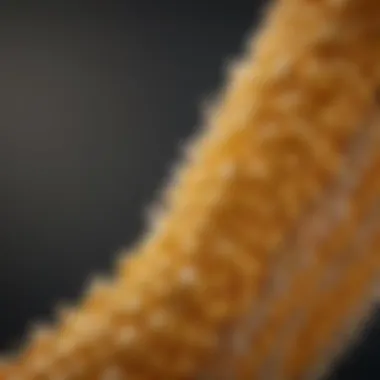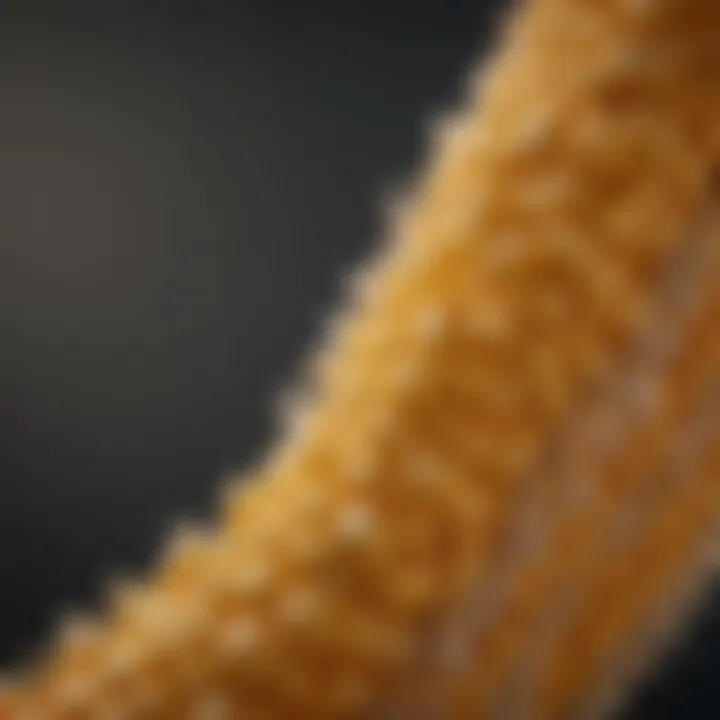Exploring the Complexities of Corn-Based Plastics


Intro
The emergence of corn-based plastics represents a significant shift in the discourse surrounding sustainable materials. In a world increasingly aware of the environmental ramifications of traditional petroleum-based plastics, exploring alternative sources for plastic production is not just timely; it's essential. Corn, a crop deeply embedded in both agricultural practices and economic frameworks, presents a dual narrative—one of promise and pragmatism.
The rise of bioplastics brings forth a series of questions ranging from their efficiency to environmental viability. As industries and consumers alike seek out greener options, corn-based plastics stand at the forefront, emphasizing a need for deeper understanding. However, the implications of adopting such materials extend beyond mere sustainability metrics. This narrative also encapsulates economic considerations, including the cost of production and raw material procurement.
In this article, we will navigate through the various dimensions of corn-based plastics. By dissecting their chemical composition and manufacturing processes, as well as assessing their applications and potential future, we aim to demystify the complexities inherent in this field. This exploration is aimed at students, researchers, educators, and professionals aiming to grasp the intricate dynamics at play.
Key Concepts
Definition of Primary Terms
Understanding corn-based plastics necessitates a clear grasp of fundamental terms. Let's delve into some of the key concepts:
- Bioplastics: Plastics that are derived from renewable biomass sources, such as corn, sugarcane, or even algae.
- PLA (Polylactic Acid): A specific type of bioplastic created from corn starch. It has gained traction due to its versatility in applications like packaging and disposable items.
- Corn Starch: The primary feedstock used in the production of PLA, extracted from the kernels of corn. It plays a crucial role in the formation of bioplastics.
Related Concepts and Theories
Several principles and theories underpin the relevance of corn-based plastics:
- Sustainability Framework: Evaluates the long-term viability of materials, considering their life cycle from cultivation to disposal.
- Eco-Efficiency: A measure of the environmental impacts per unit of performance, critical in assessing the true benefits of corn-based plastics compared to their fossil fuel counterparts.
- Circular Economy: This concept emphasizes reusing materials and minimizing waste, where corn-based plastics can fit into the larger narrative of resource efficiency.
"The real challenge lies not only in creating alternatives but ensuring they are backed by sound science and sustainable practices."
Future Directions
Gaps Identified in Current Research
As promising as corn-based plastics may appear, researchers have identified several critical gaps:
- Long-Term Environmental Impact: More studies are needed to assess the biodegradability of corn-based plastics in various ecosystems over extended periods.
- Economic Feasibility: Understanding the cost-benefit ratio compared to petroleum-based plastics requires further analysis.
- Consumer Awareness: Empirical data on public perception and understanding of corn-based plastics is lacking, indicating a need for outreach and education.
Suggestions for Further Studies
To strengthen the field of corn-based plastics, the following areas warrant further investigation:
- Exploring new feedstock options that may yield better performance or sustainability metrics.
- Developing methods to enhance the recyclability of corn-based plastics to align with circular economy principles.
- Conducting comprehensive life cycle assessments to identify potential environmental trade-offs.
Through an in-depth exploration of these topics, one can uncover the true potential of corn-based plastics. They embody not merely a solution, but a stepping stone towards rethinking material usage in an era increasingly driven by sustainability.
Preamble to Bioplastics
The topic of bioplastics, particularly corn-based plastics, is more relevant than ever in today's world. With growing environmental concerns revolving around the detrimental effects of traditional petroleum-based plastics, understanding bioplastics offers hope for a sustainable materials future. Corn-derived plastics are at the forefront of this discussion, showcasing potential benefits alongside notable challenges. This article endeavors to peel back the layers of corn-based plastics, illuminating their production, applications, and their role in the shift towards greener alternatives.
Defining Bioplastics
Bioplastics are a category of plastics that are either made from renewable biomass, like corn, or designed to be biodegradable. The significance of this distinction lies in their potential to reduce reliance on fossil fuels. Unlike conventional plastics, which are primarily derived from oil, these materials hold the promise of being less harmful to our environment. Bioplastics can be made via various methods, incorporating different feedstocks. Corn-derived plastics, such as polylactic acid (PLA), exemplify how agricultural resources can be transformed into functional materials.
As our world increasingly grapples with plastic waste, the definition of bioplastics must evolve. The question of sustainability goes beyond the sourcing—it also includes how these materials perform in their lifecycle. Thus, defining bioplastics requires a thorough examination of their ecological impact, from production to disposal.
Historical Context of Bioplastics
The journey of bioplastics is rooted in innovation. The idea of using organic materials for creating plastics is not entirely new; it traces back to the 19th century with modifications made to casein, derived from milk, and natural rubber. However, the modern movement toward bioplastics gained momentum in the late 20th century as environmental awareness burgeoned.
The introduction of PLA in the early 2000s marked a turning point, signaling a real commitment to developing alternatives to traditional plastics. Corn, being abundant and economically viable, became a popular choice for manufacturers. The shift towards corn-based plastics was not merely rooted in environmental concerns but also in cultural and agricultural practices prevalent in regions such as the Midwestern United States.
Understanding the historical context of bioplastics, particularly corn-based, enables us to appreciate the complexity surrounding its development and acceptance. This historical lens offers insight into how technological advancements and shifts in consumer behavior can drive future innovations in the bioplastics sector.
The Science Behind Corn-Based Plastics


The topic of corn-based plastics, particularly through the lens of science, introduces a fascinating dynamic in the quest for sustainable materials. Understanding the chemical processes and production techniques involved in creating these plastics allows us to appreciate their potential and shortcomings. It emphasizes how the shift from traditional petroleum-based solutions can align with ecological priorities while still addressing industrial demands.
Chemical Composition of Corn Plastics
Corn plastics, specifically polylactic acid (PLA), are predominantly made from the starch in corn. This natural polymer arises from the fermentation of corn sugars, leading to a polymer structure that mirrors conventional plastic yet is biodegradable under the right conditions.
This unique aspect makes corn-based plastics appealing in many applications. They’re made from renewable resources, capturing the attention of industries keen on reducing their carbon footprint.
The molecular structure of PLA allows for flexibility in various applications. Corn plastics can be tailored to fit several uses, from single-use packaging to durable goods. This versatility is crucial as it aids in reducing reliance on fossil fuels, proving that science and environmental responsibility can indeed walk hand in hand.
Production Techniques
Producing corn-based plastics is a multi-faceted endeavor, centered on two main processes: Fermentation Process and Polymerization Methods.
Fermentation Process
The fermentation process forms the backbone of creating PLA from corn. First, corn starch is converted into sugars. Next, these sugars undergo fermentation, led by specific microorganisms that convert them into lactic acid. This lactic acid can then be polymerized into PLA.
The key characteristic of this method is its potential for sustainability. Since corn is abundant and often grown in rotation with other crops, this process capitalizes on existing agricultural systems. Additionally, it is noteworthy that the fermentation process can yield high levels of lactic acid with relatively low waste, marking it as a beneficial choice for producing corn-based plastics.
However, there are some drawbacks worth noting. One issue is that large-scale corn production could lead to monoculture farming, potentially harming biodiversity. Moreover, reliance on agricultural processes may lead to fluctuations in availability due to climatic changes or crop failures.
Polymerization Methods
The subsequent step involves the polymerization of lactic acid into polylactic acid. This can occur through various methods, including ring-opening polymerization. The innovation in polymerization is critical as it determines the properties of the final product.
The key advantage of these methods lies in their ability to control the molecular weight and thus affecting the plastic's physical characteristics—like its melting temperature and mechanical strength. As a popular choice for converting lactic acid into PLA, these techniques enable manufacturers to produce corn-derived plastics that meet a diverse set of performance standards required for different applications.
Nevertheless, challenges remain. The energy demands of polymerization processes differ, and some methods may produce more greenhouse gas emissions than preferred, necessitating a careful balance between efficiency and environmental impact.
In summary, the fascinating science behind corn-based plastics intertwines chemistry and eco-conscious practices, pushing boundaries while still grappling with essential sustainability principles. This intricate dance of processes underscores the need for further innovation and critical assessment as we look toward an era of greener alternatives.
Applications of Corn-derived Plastics
The use of corn-derived plastics has grown exponentially over recent years, finding footholds in various industries due to the increasing concerns over environmental sustainability. The applications of these bioplastics extend across multiple sectors, each benefitting from the unique properties of corn-based materials. Here, we will explore three key areas: the packaging industry, textiles and fibers, and medical applications, highlighting their significance and potential.
Packaging Industry
In the realm of packaging, corn-derived plastics are nothing short of revolutionary. Traditional plastic packaging is notorious for its environmental impact, often contributing to pollution and waste. Conversely, plastics made from corn starch, such as polylactic acid (PLA), present a more eco-friendly alternative.
- Biodegradability: One of the most compelling attributes of corn plastics is their ability to decompose over time, reducing landfill burdens.
- Versatility: Products like cups, cutlery, and food containers crafted from corn plastics serve as excellent substitutes for conventional packaging materials.
- Aesthetic Appeal: Many consumer goods businesses opt for corn-based packaging not just for sustainability, but also for the appealing textures and finishes that can enhance product presentation.
In a time where consumers are even more conscious of environmental footprints, companies that offer corn-based packaging can enjoy an edge in the market. However, many manufacturers must navigate the balance between cost-efficiency and sustainable practices, often finding themselves at a crossroads.
Textiles and Fibers
A surprising, yet promising application of corn plastics is within the textile industry. Innovations in biotechnology have enabled the production of fibers from corn, presenting new possibilities for eco-friendly fabrics.
- Natural Fiber Blends: Corn-derived fibers can be blended with traditional materials. This blend not only improves the fabric's sustainability but also enhances its durability, ensuring that it withstands the rigors of everyday wear.
- Dyeing and Processing: Biodegradable textiles offer significant advantages during dyeing and processing, as the chemicals involved can potentially reduce environmental damage.
- Consumer Preference: As awareness grows around sustainable practices, an increasing number of consumers are seeking out clothing made from environmentally-friendly materials, driving demand and innovation in the market.
The ability to create textiles that are both sustainable and aesthetically pleasing poses a ripe opportunity for fashion brands and manufacturers alike.
Medical Applications
In the medical sector, the relevance of corn-derived plastics is evident and multifaceted. They serve critical roles in creating items like sutures, drug delivery systems, and surgical implants, all with considerable benefits over traditional materials.
- Biocompatibility: Many corn-based polymers exhibit excellent compatibility with human tissue, which is paramount for medical applications. This property minimizes the risk of rejection or adverse reactions.
- Sustainability: Given the soaring demand for eco-friendly solutions, using corn plastics in medical devices underscores a commitment to sustainable healthcare practices.
- Innovative Solutions: Research is ongoing to explore new ways to utilize bioplastics in innovative medical solutions. This includes creating scaffolds for tissue engineering or biodegradable packaging for pharmaceutical products.
"Using corn-derived materials in health care could pioneer future advancements that merge sustainability with lifesaving technologies."
As these applications illustrate, corn-derived plastics are not merely a passing trend; they represent a substantial shift in how we approach materials across various industries. This adaptability not only demonstrates their viability but also highlights the broader implications of embracing sustainable practices in our everyday lives.


Sustainability Considerations
Sustainability in the context of corn-based plastics is a topic of increasing significance as we grapple with the environmental consequences of our material choices. The growing concern over plastic pollution has compelled industries and consumers alike to consider alternatives. Corn-derived plastics have surfaced as a viable candidate, offering several environmental advantages over traditional petroleum-based plastics.
What makes corn plastics particularly compelling in this discussion is their nature as a renewable resource. Conventional plastics, predominantly derived from fossil fuels, contribute to the depletion of irreplaceable resources. Corn, on the other hand, can be replanted every year, thus presenting a more sustainable lifecycle. Moreover, the use of agricultural by-products in plastic production can reduce waste, contributing positively to waste management.
"Corn-based plastics represent a shift towards a circular economy, where materials are continuously reused and repurposed rather than discarded."
Let’s break down the implications of these sustainability considerations further.
Lifecycle Assessment
A lifecycle assessment (LCA) of corn-based plastics involves evaluating their environmental impacts from cradle to grave, effectively assessing the sustainability of these plastics. This evaluation typically includes the raw material extraction, production processes, usage, and disposal or recycling.
- Raw Material Input: Corn cultivation involves water usage, soil quality, and land resources, which need to be carefully monitored to prevent negative ecological impacts.
- Production Footprint: The production of corn plastics, while emerging as less harmful than that of petroleum plastics, is not without its own challenges. Energy consumption during fermentation and polymerization can still impact the environment.
- End-of-Life Options: One of the most appealing aspects of corn-based plastics is their potential for biodegradability. However, the actual implementation of effective composting and recycling practices still lags behind expectation.
Carbon Footprint
The carbon footprint of corn-based plastics is another vital factor in discussions about their sustainability. In essence, it denotes the total greenhouse gas emissions produced throughout the lifecycle of these materials. Corn-derived plastics can present a more favorable carbon footprint when compared to traditional plastics since they utilize carbon dioxide absorbed by the corn during its growth.
- Cultivation Emissions: Although the growth of corn captures CO2, it also involves emissions from fertilizers and pesticides. Sustainable farming practices can mitigate these emissions significantly.
- Production Emissions: The conversion of corn into plastic can release carbon in various stages, including fermentation and polymerization. Modifying these processes to reduce energy consumption is crucial for minimizing overall emissions.
- Comparative Emissions: When juxtaposed with petroleum plastics, many studies suggest that corn-based plastics can have a smaller carbon footprint, yet it's essential to remember that this is highly contingent upon agricultural practices and production efficiency.
In summary, while corn-based plastics offer a promising alternative to petroleum-derived materials, their sustainability hinges on responsible agricultural practices, efficient production methods, and effective end-of-life solutions. Only through continuous innovation and stringent assessments can we genuinely harness the benefits of these materials while minimizing their drawbacks.
Economic Viability of Corn Plastics
The economic viability of corn-based plastics is a critical area of exploration, especially considering the increasing demand for sustainable materials in various industries. To understand its significance, one must first recognize how it stands juxtaposed with traditional petroleum-based plastics. Economic viability encompasses not just the cost of production, but also market dynamics, consumer preferences, and broader industry trends.
Corn-derived plastics, primarily made from polylactic acid (PLA), may offer advantages in renewability, but their price point can be a double-edged sword. The cost factors involved in sourcing corn, production, and processing need careful scrutiny, especially when compared to the well-established fossil fuel plastics which generally enjoy economies of scale. Despite higher initial production costs, the push for environmentally friendly materials has led many companies to factor sustainability into their cost assessments, creating a new economic landscape.
In short, evaluating the economic viability of corn plastics is essential, as it not only reveals the financial implications for producers and consumers but also underscores the material's potential role in a greener economy.
Cost Analysis
Cost analysis plays a pivotal role in determining the economic feasibility of corn-based plastics.
- Raw Material Costs: The price of corn fluctuates based on agricultural yield, weather patterns, and market demand. When corn prices spike due to drought or other factors, the costs associated with bioplastics can also rise. This directly impacts affordability.
- Production Expenses: The processes involved in converting corn to plastic—such as fermentation and polymerization—incur costs that can be higher than those for producing traditional plastics. While these methods are advancing, they still may not match the efficiency of petroleum-derived processes.
- Scale of Production: Start-up operations that produce smaller quantities of corn plastics may face higher per-unit costs. However, as demand grows and economies of scale can be realized, these costs could decrease.
- Government Subsidies and Policies: Support from government entities can influence the economic landscape. Incentives for using renewable resources can help offset costs and enhance a product’s marketability.
Ultimately, the cost analysis operationalized within corn plastic production illuminates the delicate balance between cost and sustainability, influencing strategic decisions by manufacturers and retailers alike.
Market Demand and Trends
The market demand for corn-based plastics is an ever-evolving narrative shaped by consumer awareness, policy-driven incentives, and innovation.
- Consumer Preferences: Increasingly, consumers are opting for products that boast eco-friendliness, pushing companies to rethink their material choices. A shift towards sustainable products in everyday items, from packaging to consumer goods, has spurred demand for corn-derived options.
- Investment in R&D: As companies recognize the benefits of corn plastics, there is a noticeable increase in investment in research and development. Innovations in production processes could lead to reduced costs and improved characteristics of bioplastics, making them more competitive against conventional options.
- Global Policy Trends: Government regulations surrounding plastic use are also influencing market dynamics. With an eye on reducing plastic waste, legislation that encourages biodegradable materials can further bolster the market demand for corn-based plastics.
- Future Outlook: The trend towards a circular economy presents corn-based plastics with substantial growth prospects. As durability and recyclability improve, it’s likely that more consumers and industries will turn to these materials as viable alternatives.
In summary, understanding market demand and trends surrounding corn plastics reveals an optimistic trajectory. With increasing consumer advocacy for sustainable materials and a concerted push towards innovation, the economic viability of corn-based plastics stands to improve in the coming years.
Comparative Analysis
In the exploration of corn-based plastics, comparative analysis serves as a crucial anchor. It provides a vantage point from which the multifaceted strengths and weaknesses of corn-derived plastics can be assessed relative to their petroleum-based counterparts. This analysis is not just an academic exercise; it's vital in shaping informed decisions for future material use in various industries. Understanding these nuances helps stakeholders—from manufacturers to policymakers—navigate the complex landscape of sustainable materials.
Corn Plastics vs. Petroleum-Based Plastics
When we pit corn plastics against petroleum-based plastics, the conversation becomes layered with various dimensions. Here are some notable aspects to consider:
- Source of Raw Material: Corn-based plastics rely on renewable resources—primarily corn starch—while petroleum-based plastics draw from fossil fuels, a limited resource that has far-reaching environmental implications.
- Production Processes: The methods of processing corn into plastics differ fundamentally from those used for petroleum. Corn plastics, often produced through fermentation and polymerization, embody a more sustainable pathway that can potentially minimize fossil fuel dependency. Conversely, petroleum plastics typically involve energy-intensive refining processes.
- Biodegradability: Another major differentiator is the biodegradability of corn plastics. They tend to break down more naturally in a composting environment compared to traditional plastics, which can persist in the environment for centuries, contributing to severe pollution problems.
- Toxicity and Environmental Harm: The life cycle of corn plastics tends to have a lower toxicity profile, especially concerning chemicals released during production and disposal. In contrast, the global proliferation of petroleum plastics has resulted in adverse health and environmental impacts, raising serious concerns within various communities.
- Cost Structures: While corn-derived plastics might initially appear costlier due to processing requirements and agricultural resources, ongoing advancements and a growing market could tip the scales in favor of eco-friendly alternatives. Gradually shifting consumer preferences towards sustainable products could bolster demand and drive prices down.
"Evaluating corn plastics and petroleum-based plastics is key to understanding which path leads us toward sustainability and reduced environmental harm."


Environmental Impact Assessment
A thorough environmental impact assessment of corn plastics against traditional counterparts is indispensible in today's ecological landscape. This not only includes comparing emissions and resource utilization during production but also considers post-consumer waste management.
- Resource Dynamics: Producing corn-based plastics often consumes water and land differently than petroleum plastics. Depending on agricultural practices, this can either mitigate or exacerbate resource depletion.
- Greenhouse Gas Emissions: A pivotal point in assessing environmental impact is greenhouse gas emissions. Many studies indicate that corn plastics offer a reduction in carbon footprint relative to petroleum-based options when assessing their full lifecycle.
- Land Use Changes: The expansion of corn production for plastic production can lead to questions about land use practices. Are we displacing food production or contributing to deforestation? This is an important angle to investigate further.
Ultimately, the comparative analysis elucidates the broader conversation around sustainable materials and their role in mitigating climate change while addressing economic viability. By scrutinizing both corn-based and petroleum-derived plastics, we form a clearer picture of what future advancements may entail in bioplastics. It's an intricate dance between innovation and practicality that merits ongoing study and deliberation.
Challenges and Limitations
When we dive into the topic of corn-based plastics, examining the challenges and limitations becomes critical. These facets not only shape the practicality of corn-derived materials but also dictate their acceptance in the marketplace. In a world increasingly focused on sustainability, understanding these elements is crucial for both consumers and producers alike. Addressing the hurdles corn-based plastics face can pave way for innovative solutions and improved practices in bioplastics production, ultimately enhancing the broader dialogue on environmental stewardship and material science.
Agricultural Concerns
The agricultural implications of using corn as a feedstock for plastic production are significant. Primarily, the demand for corn to supply bioplastic production can lead to shifts in farming practices. Farmers, like anyone in the business, are often looking for lucrative crops. If corn becomes a hot commodity for plastics, it can pull resources away from food production. The risk is that we may end up prioritizing plastic over sustenance, which invites ethical questions about agricultural practices.
Moreover, intensive corn farming can raise questions about land use and biodiversity. High volume corn production often translates to monoculture—a practice that can deplete soil nutrients and raise vulnerability to pests. When fields are dedicated to this single crop, ecosystem balance wanes, diminishing habitats for a variety of species.
Additionally, there are concerns about the use of pesticides and fertilizers related to corn cultivation, which can pose environmental hazards. Chemicals used in conventional corn farming can leach into local waterways, impacting aquatic ecosystems and potentially affecting human health. As these practices become more common due to rising corn demand, the environmental footprint becomes a pivotal point in the sustainability debate surrounding bioplastics.
Technological Barriers
Transitioning from a petroleum-based plastic industry to one that embraces corn-derived options isn't only a matter of material availability, but also hinges on technological advancements. Right now, there are several hurdles that technologists and producers face. One significant barrier is the scalability of production methods. While lab-scale production of corn-based plastics demonstrates promise, translating these processes to a commercial scale introduces complexities.
The efficiency of converting corn into usable plastics requires further refinement. Current techniques often entail high energy inputs and extended processing times, making large-scale production economically challenging. If corn plastics don’t become as cost-effective as their petroleum counterparts, their adoption will lag.
Moreover, product performance remains a concern. Many corn-based plastics might not match the durability and versatility of traditional plastics. For instance, while they may work well for some applications like packaging, they might lack the strength required for products that demand high-performance material. This performance gap can dissuade manufacturers from fully switching to bioplastics.
In summary, both agricultural concerns and technological barriers complicate the landscape for corn-based plastics. Addressing these issues with innovative strategies will be pivotal for advancing both the market and environmental benefits of corn-derived materials.
Future Prospects in Bioplastic Innovation
The future of bioplastics, particularly those derived from corn, is a focal point of discussion in sustainability and materials science. As we face mounting environmental challenges linked to conventional plastics, innovation in bioplastics presents a promising avenue. With rapid technological advances and increasing consumer awareness, the potential for corn-derived plastics is shifting from a theoretical possibility to practical applications.
Advancements in Production Methods
Recent years have seen a significant transformation in the production methods of corn-based plastics. Researchers and companies are exploring fermentation techniques beyond traditional pathways, pushing the envelope on yields and efficiency. Innovations such as using genetically engineered microorganisms can produce polylactic acid (PLA) more effectively from corn starch. This not only enhances production rates but also reduces the carbon footprint associated with manufacturing.
Moreover, integrating circular economy principles into production processes can substantially minimize waste. For instance, utilizing by-products from corn processing can lead to a synergistic material recovery system. Companies are experimenting with blockchain technology to track the lifecycle of these bioplastics, ensuring more transparent and sustainable practices.
This progress is crucial as it not only boosts productivity but also aligns with global sustainability goals, making corn-based bioplastics a viable alternative to petroleum-based options.
Potential New Markets
The landscape for corn-based plastics is not limited to existing applications. As innovation continues, so do the opportunities. New markets can emerge in sectors such as automotive, consumer goods, and even construction. For instance, lightweight bioplastic materials can enhance fuel efficiency in vehicles while providing the same functionality as traditional materials. In the realm of consumer goods, companies are increasingly inclined to offer eco-friendly packaging options that leverage corn-based plastics, aligning with evolving regulatory expectations around plastic pollution.
Additionally, the medical industry stands poised to benefit significantly from bioplastics. Applications include biodegradable sutures and drug delivery systems that can reduce long-term waste and improve patient outcomes. As the conversation around sustainability grows, collaborations between researchers and industry players will be vital in exploring untapped markets.
Culmination
In exploring the intricacies of corn-based plastics throughout this article, it becomes abundantly clear just how pivotal this subject is in today's ecological and economic discussions. While many innovations are being touted as the 'next big thing' in sustainability, corn-derived plastics present a distinct mixture of promise and complexity that deserves a closer look.
Summary of Key Findings
When we peel back the layers, there are several salient points that stand out. Corn-based plastics, primarily made of polylactic acid (PLA), are increasingly being utilized across different sectors—from packaging to medical applications. Their biodegradable nature sets them apart, aligning well with the pressing need to reduce plastic waste.
- Chemical Composition: The basis of these plastics lies in the sugars extracted from corn, which are fermented to produce lactic acid before being polymerized into PLA.
- Sustainability Insights: While the environmental benefits are worthy of recognition, it's crucial to acknowledge that the production process isn't devoid of challenges, such as land usage and pesticide application.
- Economic Viability: The market potential is bright, yet prices compared to traditional plastics sometimes make enterprises hesitant.
As we analyze these points, it’s evident that while corn plastics represent a significant advancement, the overall sustainability of their production requires ongoing scrutiny. It's a balancing act between encouraging innovation and ensuring responsible agricultural practices.
The Path Forward
Moving ahead, the roadmap for corn-based plastics appears filled with opportunities but also a fair share of hurdles. It’s imperative that stakeholders from various sectors work hand-in-hand to propel this industry forward.
- Advancements in Biodiversity: Exploring cultivation variations can lead to less environmentally taxing practices. Companies may want to look into sourcing non-GMO corn or even cultivating in less eco-sensitive areas to limit the agricultural impact.
- Investment in R&D: A concerted effort in research and development can drive the discovery of new production methods that reduce costs and carbon footprints.
- Public Awareness and Demand: Educating consumers about the real benefits and potential drawbacks of corn plastics can foster a more informed marketplace, helping to shift demand towards more sustainable materials.



